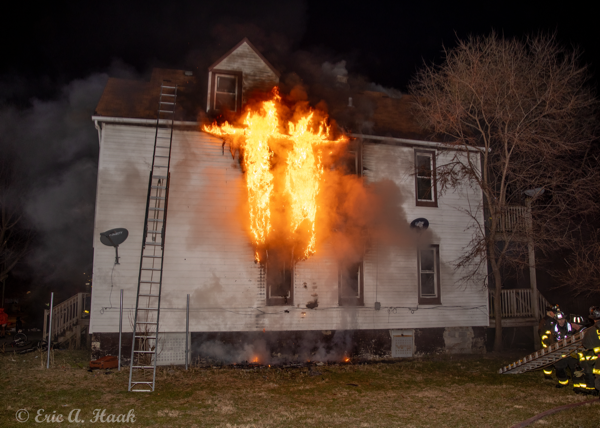This from Eric Haak:
Here are a few images of a still & box alarm in Chicago’s 5th Battalion on Sunday morning (3/21). The building was vacant.

Eric Haak photo
Mar 23
Posted by Admin in Apparatus on-scene, Fire Scene photos | Comments off
This from Eric Haak:
Here are a few images of a still & box alarm in Chicago’s 5th Battalion on Sunday morning (3/21). The building was vacant.

Eric Haak photo
Tags: #EONEStrength, Chicago FD Engine 50, Chicago Fire Department, E-ONE fire engine at fire scene, Eric Haak, house fire in Chicago, night fire scene photos
This from @chicagoland_fire_photos on instagram:
This was a visit to Engine 115 about 3 days before their new house opened

chicagoland_fire_photos on instagram
Tags: Chicago FD Engine 115, Chicago FD Engine 115's house, Chicago Fire Department, Chicago Fire Station, Chicago firehouse
Mar 23
Posted by Admin in Fire Department History | 1 Comment
Another installment about History of Evanston Fire Department
While there were four steam fire engine manufactures under the AFEC umbrella, Ahrens was by far the biggest and most-successful. Ahrens built its Metropolitan steamer in various sizes, and it was sold to fire departments — including the Evanston F. D. — across the country throughout the 1890s. Ahrens also manufactured the radical / eccentric, overly-heavy, and not very successful “Columbian,” which was built for and displayed at the World’s Columbian Exposition at Jackson Park in Chicago in 1893. The Columbian featured both a standard steam engine AND a hose supply-bed on the same rig. The common practice at the time the Columbian was being introduced and marketed was for an engine company to operate with a steam fire engine and a hose cart running as separate rigs, and unfortunately for Ahrens, most fire chiefs at that time just could not see the advantage of combining the two functions in one apparatus.
While the American Fire Engine Company was attempting to establish itself as the “big dog” in the world of steam fire engines, the LaFrance Fire Engine Company was busy acquiring patents for both the Hayes and the Babcock aerial-ladders, the two most popular aerial-ladder designs of the 19th century, effectively giving LaFrance control over the manufacture of all aerial-ladder trucks built in the U. S. It was not until 1900 — when the American Fire Engine Company merged with LaFrance, Amoskeag, and a number of other manufacturers of firefighting equipment and apparatus such as the Rumsey Company, Gleason & Bailey, the Charles T. Holloway Company, and the Macomber Fire Extinguisher Company to form the International Fire Engine Company, that the trust was fully established.
The International Fire Engine Company name was changed to American-LaFrance Fire Engine Company as all production moved to the LaFrance plant in Elmira, NY, in 1904, but just as with AFEC ten years earlier, post-merger profits were not as great as had been anticipated, in part thanks to a new kid on the block.
The Seagrave Corporation was located in Columbus, OH, and while Seagrave did not build steam fire engines, it did manufacture first-rate horse-drawn chemical engines and hook & ladder trucks, as well as the very popular “combination truck,” so-called because it combined a chemical engine and a hook & ladder truck in one apparatus. Seagrave combination trucks were in service with fire departments across the U. S., and then beginning in 1900, Seagrave started manufacturing horse-dawn aerial-ladder trucks that competed successfully with the American-LaFrance aerial-ladder truck.
Meanwhile, tired of living the life of a retired independently wealthy squire, Chris Ahrens rediscovered his latent entrepreneurial spirit and sold his share in American-LaFrance in 1904. Together with sons John and Fred and son-in-law and Cincinnati Fire Chief Charles H. Fox, formed a new company called the Ahrens Fire Engine Company at the old Ahrens Manufacturing Company plant in Cincinnati. The company’s name was changed to the Ahrens-Fox Fire Engine Company in 1908 when Charles Fox became company president, and it quickly became the # 2 steam fire engine manufacturer and American-LaFrance’s chief competitor in the area of steam fire engines. But it wasn’t easy.
Because American-LaFrance retained all patents held by the various companies that formed ALF — including the Metropolitan patent originally filed by Chris Ahrens in the 1890s — Ahrens-Fox could not build the Metropolitan. And so instead, Chris Ahrens invented, developed, and built a completely new steam fire engine called the “Continental” that did not infringe on any existing patents, and in fact the Ahrens-Fox Continental sold very well, and might even have eventually matched or even exceeded American-LaFrance’s Metropolitan in sales, except the steam fire engine era came to a rather abrupt end in 1915.
Tags: Ahrens Fire Engine Company, Ahrens Manufacturing Company of Cincinnati OH, Ahrens-Fox Fire Engine Company, American Fire Engine Company., American LaFrance, Amoskeag, Button, chicagoareafire.com, Chicagoareafire.com/blog, Chris Ahrens, Cincinnati Fire Chief Charles H. Fox, Clapp & Jones, Evanston Fire Department history, History of Evanston Fire Department, LaFrance Fire Engine Company, Phil Stenholm, Seagrave Corporation, Silsby
You are currently browsing the archives for Tuesday, March 23rd, 2021

For the finest department portraits and composites contact Tim Olk or Larry Shapiro.
Arclite theme by digitalnature | powered by WordPress